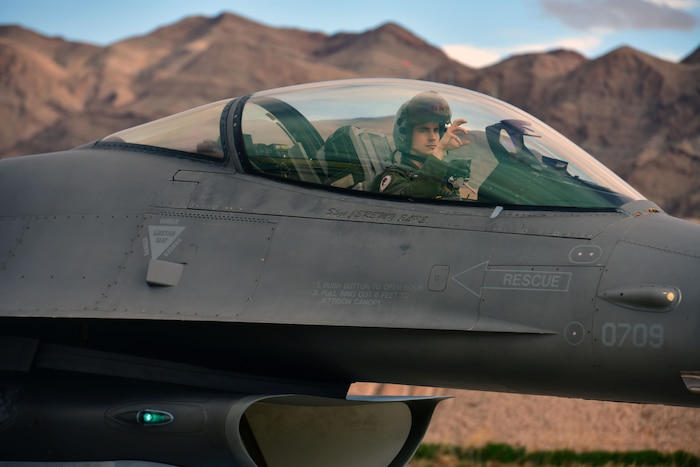On January 30, the British Royal Air Force released striking footage depicting the dramatic moment when a tire on a Royal Air Force air-to-air refueling aircraft encountered a tire burst during takeoff.
The incident occurred during Exercise Red Flag in Nevada as the aircraft, weighing 204 tons and carrying 80 tons of fuel, accelerated down the runway at approximately 160 mph.
The video depicts rubber debris flying off the aircraft as it accelerated while the crew, initially unaware of the severity of the situation, detected minor vibrations.
Upon becoming airborne, the aircraft’s tire pressure sensors indicated issues with two tires, prompting the crew to utilize exterior inspection cameras to assess the damage.
In a proactive measure, the crew also reached out to a US Air Force F-16 fighter jet participating in the exercise for a visual inspection. Subsequently, the Voyager’s captain and crew evaluated the damage to devise a safe landing strategy.
The moment the tyre of a Royal Air Force air-to-air refuelling aircraft blew-out during take-off has been captured on camera. 🛞
More on this story 🔗 https://t.co/ZwPIHsuc5M pic.twitter.com/oMWaXMMOj8
— Royal Air Force (@RoyalAirForce) January 30, 2024
Corporal Jaz Lawton, the cabin supervisor, reflected on the incident, stating that despite the shock of the burst tire, training enabled them to effectively communicate with passengers and maintain reassurance throughout the ordeal.
To mitigate risks associated with landing on damaged wheels, the crew extended their sortie to reduce fuel load, thereby minimizing weight onboard.
This also allowed other fighter jets to return to base before the Voyager, considering potential runway damage upon landing.
Furthermore, the crew coordinated with US Air Force firefighters at Nellis Air Force Base to prepare for recovery operations, positioning them alongside the runway.
Despite the challenges, the skilled pilots executed a successful landing, with firefighters promptly inspecting the aircraft post-landing, confirming its condition for a slow taxi back to its parking space.
The Voyager’s captain commended the teamwork exhibited under pressure, emphasizing the reassuring effectiveness of the broader team.
The captain of the Voyager said, “This has been an eventful day, but it is reassuring to be part of a wider team that operates so effectively under pressure.”
Following the incident, RAF engineers worked tirelessly through the night to replace the damaged wheels, ensuring the Voyager’s readiness to resume its critical role in the exercise the following day.
Red Flag Exercise
The Voyager aircraft is currently supporting both UK and US fighter jets participating in aerial combat training during Exercise Red Flag.
This ongoing exercise, held from January 15 to February 2 at Nellis Air Force Base in Nevada, USA, serves as a convergence point for approximately 3,000 servicemen from the United States, United Kingdom, and Australia.
Throughout the exercise, missions are conducted not only within the nearby Nevada Test and Training Range but also extend further to the southwest of the United States.
Approximately 100 aircraft and 3,000 servicemen from the US, UK, and Australia engage in various drills to enhance Allied integration, logistics, and tactical proficiency.
Exercise Red Flag Nellis, which was established in 1975, intersects with current geopolitical dynamics, notably the involvement of US and UK air forces in strikes against Houthi targets in Yemen.

This year’s Red Flag, as emphasized by RAF Wing Commander Paul Summers, assumes added significance amidst a backdrop of increasing global instability.
The UK-based Daily Mail reported that discussions from the US and Australian contingents revolve around sharpening skills for potential operations in the Indo-Pacific region, particularly in light of perceived tensions with China. However, the UK has its own immediate concerns, notably the ongoing conflict in Ukraine.
Originally, the exercise aimed to provide pilots with the experience equivalent to their first ten combat missions within a safe training environment. However, now, its primary objective is the integration of Allied Forces and their preparedness for the evolving landscape of global conflict.
The exercise divides participating teams into two factions: the Blues, representing the Allies, and the Reds, comprised of pilots trained to employ tactics mimicking potential aggressors, with simulated enemy weaponry loaded onto their aircraft.
Drills conducted for three weeks encompass four critical scenarios: defending Allied airspace, penetrating enemy airspace, targeting ground installations, and neutralizing air defenses.
In this complex operational setup, the RAF Voyager tanker assumes a critical role by facilitating the refueling of F-35s, Typhoons, and other fighter jets involved in the exercise.
- Contact the author at ashishmichel(at)gmail.com
- Follow EurAsian Times on Google News